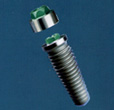
| |
||||
Replace® Select Abutments |
 |
|||
|
Abstracts New Evaluation of the Precision of Fit Between the Procera Custom Abutment and Various Implant Systems-New Lang LA, Sierraalta M, Hoffensberger M, and Wang R-F. Evaluation of the precision of fit between the Procera Custom Abutment and various implant systems. Oral Maxillofac Implants 2003;18:652-658. Abstract: The bearing surface of the
implant and the opposing bearing surface of the implant abutment
form a screw joint that must remain stable throughout the life of
the implant restoration. The fit tolerance between the external
hexagon of the implant and the internal hexagon of the abutment
has been suggested as a factor in the stability of the abutment/implant
screw joint. Therefore, a study was designed to assess the precision
of fit of the CAD/CAM produced Procera® abutment (Göteborg,
Sweden) onto the external hexagon and bearing surfaces of implants
from various implant manufacturers, and to determine the interchangeability
of the Procera abutment screw with these systems. The following
implants were evaluated for precision of fit of their external hexagons
with the platform internal hexagon bearing surface of the Procera
custom abutment: 1) BRÅNEMARK® System - Conical Self-Tapping
3.75 X 10 mm implants (Nobel Biocare, Göteborg, Sweden), 2)
Lifecore Restore - 3.75 X 10 mm implants (Lifecore Biomedical, Chaske,
MN), 3) Implant Innovations Inc. (3I) System - 3.75 X 10 mm implants
(West Palm Beach, FL), 4) ImplaMed - 3.75 X 10 mm implants (Sunrise,
FL), and 5) Paragon - Taper-Lock 4.0 X 10 mm (Encino, CA). A direct
measurement was made of the external hexagon and the bearing surface
of each implant, and the internal hexagon and bearing surface of
each Procera abutment. The mean flat-to-flat hexagon dimensions
of the implants ranged from 2.67 to 2.69 mm. The Procera abutment’s
flat-to-flat dimension was 2.73 mm. The height dimension of the
implant systems external hexagon ranged from 0.69 to 0.81 mm. The
height of the Procera abutment blanks was 0.90 mm. From the measurement
data, the Procera abutment fit all of the implants measured in this
study. Thirty Procera abutments were produced by CAD/CAM with a
uniform collar and height. Each implant and its Procera abutment
formed one sample. Each sample was placed in a rigid device to ensure
solid fixation without rotation for tightening of the abutment screw.
The Procera custom abutment was tightened using the abutment screw
specific to each of the five different implant systems. Each abutment
screw was tightened to 32 Ncm using a calibrated electro-torque
controller and using the internal counter torque device (Nobel Biocare,
Göteborg, Sweden). During the abutment connection procedure,
the Procera-Paragon assembly could not be tightened. Radiographic
examination of the Lifecore Restore and 3I samples demonstrated
that the manufacturers screws did not fit appropriately within the
internal screw bore of the Procera abutment and these assemblies
could not be acceptably tightened. All screw threads have a standard
profile or geometry and are usually made according to the International
Organization for Standard (ISO). Two widely used standards are the
American National (Unified) thread and the metric threads. The basic
profile of metric screw thread is specified in ISO 68 and on ANSI/ASME
B1.13M-1983 (R1989) American National Standard. Three abutment screws
and three implants from the Procera, Brånemark system, Lifecore
Restore, Implamed, 3I, and Paragon implants systems were examined
for interchangeability based on ANSI/ASME B1.13M-1983 (R1989) American
National Standard. This standard assesses the major determinants
of interchangeability by the screw profile (ANSI/ASME B1.21M), the
pitch and tolerance. The standard contains general metric criterion
for a 60-degree symmetrical screw thread with a basic 68 designated
profile . The basic thread profile is the cyclical outline in an
axial plane of the boundary between the external and internal threads.
The ISO 68 basic profile for metric screw threads is the basic M
profile with 60o symmetric threads. The basic M profile indicates
that the thread angle is 60o and a thread form in which the crest
form of the major external thread is flat, permitting corner rounding.
This profile is used where a high fatigue strength is required as
is the case with an implant abutment screw. These are expressed
by the metric M value. It was determined that the internal screw
bore of all implant systems studied had a metric thread designation
of M2 X 0.4 – 6H. The metric thread designation of all abutment
screws examined was M2 X 0.4 – 6g. The greatest variations
in the dimensions of the abutment screws measured were seen in the
diameter of the screw head. The diameter of the screw head of the
Procera abutment screw was 2.52 mm. The diameter of the screw head
of the abutment screws for Implamed (2.59 mm.), and 3I (2.69 mm.)
were larger than the Procera abutment screw head diameter, while
the diameter of the Lifecore Restore (2.43 mm.) and the Paragon
(2.15 mm.) abutment screw heads were smaller. The Paragon UCLA-type
abutment screw head diameter had the largest variation from the
Procera screw. It was 0.37 mm. smaller than the diameter of the
Procera abutment screw. |
||||
|
New
Projects | Origin of the Center
| Implants | Procera
| References Copyright
© 2001 |
||||
